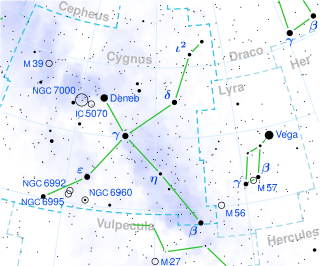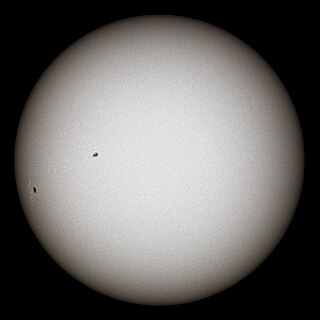Related Research Articles

The astronomical unit is a unit of length defined to be exactly equal to 149,597,870,700 m. Historically, the astronomical unit was conceived as the average Earth-Sun distance, before its modern redefinition in 2012.

Antares is the brightest star in the constellation of Scorpius. It has the Bayer designation α Scorpii, which is Latinised to Alpha Scorpii. Often referred to as "the heart of the scorpion", Antares is flanked by σ Scorpii and τ Scorpii near the center of the constellation. Distinctly reddish when viewed with the naked eye, Antares is a slow irregular variable star that ranges in brightness from an apparent visual magnitude of +0.6 down to +1.6. It is on average the fifteenth-brightest star in the night sky. Antares is the brightest and most evolved stellar member of the Scorpius–Centaurus association, the nearest OB association to the Sun. It is located about 170 parsecs (550 ly) from Earth at the rim of the Upper Scorpius subgroup, and is illuminating the Rho Ophiuchi cloud complex in its foreground.

Parallax is a displacement or difference in the apparent position of an object viewed along two different lines of sight and is measured by the angle or half-angle of inclination between those two lines. Due to foreshortening, nearby objects show a larger parallax than farther objects, so parallax can be used to determine distances.

61 Cygni is a binary star system in the constellation Cygnus, consisting of a pair of K-type dwarf stars that orbit each other in a period of about 659 years. Of apparent magnitude 5.20 and 6.05, respectively, they can be seen with binoculars in city skies or with the naked eye in rural areas without light pollution.

Luminosity is an absolute measure of radiated electromagnetic energy per unit time, and is synonymous with the radiant power emitted by a light-emitting object. In astronomy, luminosity is the total amount of electromagnetic energy emitted per unit of time by a star, galaxy, or other astronomical objects.

A binary star or binary star system is a system of two stars that are gravitationally bound to and in orbit around each other. Binary stars in the night sky that are seen as a single object to the naked eye are often resolved as separate stars using a telescope, in which case they are called visual binaries. Many visual binaries have long orbital periods of several centuries or millennia and therefore have orbits which are uncertain or poorly known. They may also be detected by indirect techniques, such as spectroscopy or astrometry. If a binary star happens to orbit in a plane along our line of sight, its components will eclipse and transit each other; these pairs are called eclipsing binaries, or, together with other binaries that change brightness as they orbit, photometric binaries.

A visual binary is a gravitationally bound binary star system that can be resolved into two stars. These stars are estimated, via Kepler's third law, to have periods ranging from a few years to thousands of years. A visual binary consists of two stars, usually of a different brightness. Because of this, the brighter star is called the primary and the fainter one is called the companion. If the primary is too bright, relative to the companion, this can cause a glare making it difficult to resolve the two components. However, it is possible to resolve the system if observations of the brighter star show it to wobble about a centre of mass. In general, a visual binary can be resolved into two stars with a telescope if their centres are separated by a value greater than or equal to one arcsecond, but with modern professional telescopes, interferometry, or space-based equipment, stars can be resolved at closer distances.

Epsilon Indi, Latinized from ε Indi, is a star system located at a distance of approximately 12 light-years from Earth in the southern constellation of Indus. The star has an orange hue and is faintly visible to the naked eye with an apparent visual magnitude of 4.674. It consists of a K-type main-sequence star, ε Indi A, and two brown dwarfs, ε Indi Ba and ε Indi Bb, in a wide orbit around it. The brown dwarfs were discovered in 2003. ε Indi Ba is an early T dwarf (T1) and ε Indi Bb a late T dwarf (T6) separated by 0.6 arcseconds, with a projected distance of 1460 AU from their primary star.

The cosmic distance ladder is the succession of methods by which astronomers determine the distances to celestial objects. A direct distance measurement of an astronomical object is possible only for those objects that are "close enough" to Earth. The techniques for determining distances to more distant objects are all based on various measured correlations between methods that work at close distances and methods that work at larger distances. Several methods rely on a standard candle, which is an astronomical object that has a known luminosity.

16 Cygni or 16 Cyg is a triple star system approximately 69 light-years away from Earth in the constellation of Cygnus. It consists of two Sun-like yellow dwarf stars, 16 Cygni A and 16 Cygni B, together with a red dwarf, 16 Cygni C. In 1996 an extrasolar planet was discovered in an eccentric orbit around 16 Cygni B.

VV Cephei, also known as HD 208816, is an eclipsing binary star system located in the constellation Cepheus. It is both a B[e] star and shell star.

Mu Cassiopeiae, Latinized from μ Cassiopeiae, is a binary star system in the constellation Cassiopeia. This system shares the name Marfak with Theta Cassiopeiae, and the name was from Al Marfik or Al Mirfaq (المرفق), meaning "the elbow". It is dimly visible to the naked eye as a point of light with an apparent visual magnitude of 5.16. The system is located at a distance of 25 light years from the Sun based on parallax, and is moving closer with a high radial velocity of −98 km/s. This star will move into the constellation Perseus around 5200 AD.

53 Camelopardalis is a binary star system in the northern circumpolar constellation of Camelopardalis, located 290 light years away from the Sun as determined by parallax measurements. It has the variable star designation AX Camelopardalis; 53 Camelopardalis is the Flamsteed designation. This object is dimly visible to the naked eye as a white hued star with a baseline apparent visual magnitude of +6.02. It is a single-lined spectroscopic binary system with an orbital period of 6.63 years and a high eccentricity of 0.718. The "a sin i" value of the primary is 280 Gm (1.9 AU), where a is the semimajor axis and i is the orbital inclination.

Kepler-35 is a binary star system in the constellation of Cygnus. These stars, called Kepler-35A and Kepler-35B have masses of 89% and 81% solar masses respectively, and both are assumed to be of spectral class G. They are separated by 0.176 AU, and complete an eccentric orbit around a common center of mass every 20.73 days.
This glossary of astronomy is a list of definitions of terms and concepts relevant to astronomy and cosmology, their sub-disciplines, and related fields. Astronomy is concerned with the study of celestial objects and phenomena that originate outside the atmosphere of Earth. The field of astronomy features an extensive vocabulary and a significant amount of jargon.

Rho Orionis, Latinised from ρ Orionis, is the Bayer designation for an orange-hued binary star system in the equatorial constellation of Orion. It is visible to the naked eye with an apparent visual magnitude of +4.44. The star shows an annual parallax shift of 9.32 mas due to the orbital motion of the Earth, which provides a distance estimate of roughly 350 light-years from the Sun. It is moving away from the Sun with a radial velocity of +40.5 km/s. About 2.6 million years ago, Rho Orionis made its perihelion passage at a distance of around 10 light-years.
HD 163840 is a binary star system in the northern constellation of Hercules. It has a combined apparent visual magnitude of 6.45, which falls just below the brightness level that is visible to the naked eye for people with normal eyesight. An annual parallax shift of 35.40 mas provides a distance estimate of about 92 light years. The system is moving closer to the Sun with a radial velocity of −33 km/s. In about 769,000 years, it will make perihelion at a separation of around 27.2 ly (8.33 pc).

HD 179070, also known as Kepler-21, is a star with a closely orbiting exoplanet in the northern constellation of Lyra. At an apparent visual magnitude of 8.25 this was the brightest star observed by the Kepler spacecraft to host a validated planet until the discovery of an exoplanet orbiting HD 212657 in 2018. This system is located at a distance of 354 light-years from the Sun based on parallax measurements, but is drifting closer with a radial velocity of −18.2 km/s.
9 Puppis is a binary star system in the southern constellation of Puppis. It was originally designated 9 Argus, being part of the now defunct Argo Navis constellation. The system is faintly visible to the naked eye as a point of light with a combined apparent visual magnitude of 5.16. The magnitude difference between the two stars is 0.65. Parallax measurements yield a distance estimate to 9 Puppis of approximately 54 light years from the Sun, with the dynamic and trigonometric parallaxes for the system being in close agreement. It is drifting closer with a systemic radial velocity of –21 km/s. The motion of the system through space is predicted to bring it as close as 42.2 light-years in about 292,000 years.
HD 72945 and HD 72946 form a co-moving star system in the northern constellation of Cancer. HD 72945 is a binary star that is dimly visible to the naked eye as a point of light with an apparent visual magnitude of 5.91. At an angular separation of 10.10″ is the fainter companion star HD 72946 at magnitude 7.25. It is being orbited by a brown dwarf. The system as a whole is located at a distance of approximately 84 light years from the Sun based on parallax measurements.
References
- ↑ Patrick Moore (2002). Philip's Astronomy Encyclopedia (revised and expanded ed.). London: Philip's. p. 120. ISBN 0-540-07863-8.
- ↑ "dynamical parallax". Astronomy Knowledge Base. Archived from the original on 2006-07-05. Retrieved 2006-07-18.
- ↑ The Mass–Luminosity Relation, University of Tennessee, Astronomy 162: Stars, Galaxies, and Cosmology, lecture notes. Accessed July 18, 2006.
- ↑ Mullaney, James (2005). Double and multiple stars and how to observe them . Springer. p. 27. ISBN 1-85233-751-6.